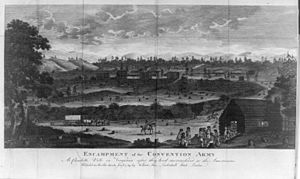Convention Army facts for kids

The Convention Army was a group of British and German soldiers. They were captured during the American Revolutionary War. This happened after the important Battles of Saratoga in 1777. These soldiers were held as prisoners of war for several years. They traveled across America before finally going home.
Contents
The Saratoga Agreement
On October 17, 1777, British General John Burgoyne surrendered his army. This happened after the Battle of Bemis Heights. He made an agreement with American General Horatio Gates. This agreement was called the Convention of Saratoga.
The agreement said that the captured soldiers would go back to Europe. But first, they had to promise not to fight in the war again. This promise is called a parole. General Burgoyne was given back his sword, which was a sign of respect.
Baroness Frederika Riedesel, whose husband was a general, saw the surrender. She wrote in her journal: "On the 17th of October the capitulation was consummated. The generals waited upon the American general-in-chief, Gates, and the troops laid down their arms, and surrendered themselves prisoners of war."
Journey to Cambridge
About 5,900 British, German, and Canadian soldiers surrendered at Saratoga. They were guarded by John Glover's troops. The soldiers then marched to Cambridge, Massachusetts. They arrived there on November 8.
The regular soldiers stayed in simple barracks. These buildings were built during the 1775 siege of Boston. Most officers stayed in houses. The army spent about one year in Cambridge. During this time, leaders talked about what would happen to the prisoners. About 1,300 prisoners escaped during this year. Many escaped because they met local women while working on farms.
The Continental Congress was the American government at the time. They asked General Burgoyne for a list of all his officers. They wanted to make sure the officers would not return to fight. When Burgoyne refused, the Congress changed the agreement. They decided to hold the army until King George III agreed to the convention. The Americans thought the King would not agree, because it would mean he accepted American independence.
Life in Virginia
In November 1778, the Convention Army started a long march south. They walked 700 miles (1,100 km) to Charlottesville, Virginia. They arrived in January 1779, during snowy weather. About 600 men escaped during this march.
The soldiers were held at the Albemarle Barracks. These barracks were built quickly and were not very good. They stayed there until late 1780. Lt. Col Joseph Crockett's Western Battalion guarded them.
Impact on the Local Economy
The army's time in Virginia had a big effect on the local economy. This was especially true for the Blue Ridge area. The Virginia soldiers guarding the prisoners were often better fed than other American troops.
The prisoners also received money from their families in Britain and Germany. This brought a lot of hard currency (money like coins) into the area. The prisoners needed food and other goods. They had to pay high prices for these items. Thomas Jefferson thought the prisoners added at least $30,000 a week to the area's money supply.
Living Conditions
High-ranking officers, like Major General Riedesel and his wife, were sometimes guests at social events. But the regular soldiers lived in very difficult conditions. Not enough money was given to build good barracks.
One officer, Lieutenant August Wilhelm Du Roi, described the barracks. He said they were 24 feet long and 14 feet wide. Each barrack was meant for 18 men. He wrote that they were "so miserable that it surpasses all that you can imagine in Germany of a very poorly built log house." The walls had big gaps, and the roof was made of logs. Many soldiers chose to camp outside in the woods. They felt they could protect themselves better from the cold there.
Some officers also caused problems. One officer was reported for visiting forbidden places at night. This caused trouble for the local people.
In late 1780, British forces became active in Virginia. So, the army was moved again. They marched north to Frederick, Maryland. They were held there until 1783, except for some officer exchanges. When the war officially ended, the soldiers who survived the long marches and illnesses were finally sent home.

